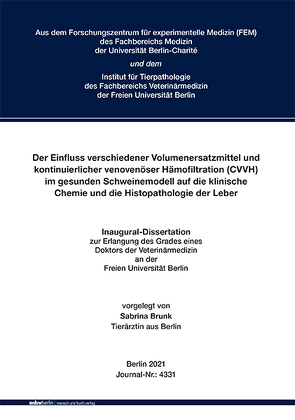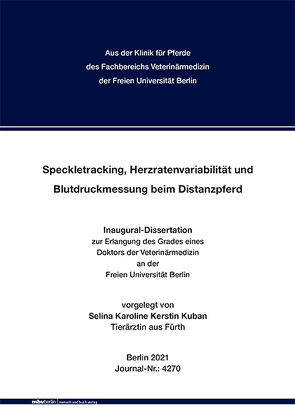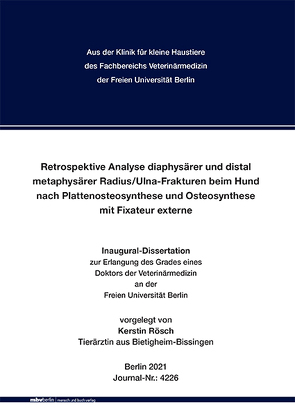
"The influence of different volume replacement fluids and continuous venovenous haemofiltration (CVVH) in a healthy pig model on the clinical chemistry and the histopathology of the liver"
The treatment of critically ill patients poses great challenges to medicine. The often multimorbid patients are subjected to a multitude of therapy components, which, in addition to anaesthesia, medication and parenteral nutrition, also include the administration of crystalloid or colloid volume substitutes and the use of extracorporeal organ-supporting systems. In clinical studies, usually only individual therapy components are considered and different concomitant therapies such as infusion management and the associated possible biocompatibility-related interactions are disregarded, which leads to contradictory results or makes comparability almost impossible.
Against this background, this animal experimental study in healthy pigs (n = 66) investigated volume replacement-specific effects of crystalloid and colloidal infusion solutions, with concomitant use of a venovenous haemofiltration circuit (CVVH) on blood chemistry and histopathological changes in the liver.
The experimental animals were randomly divided into control and CVVH groups and then assigned to five volume replacement agents (NaCl, HES130, HES200, albumin (ALB), gelatin (GEL)). The CVVH animals were connected to a haemofiltration circuit for a total of 6.5 hours and received an infusion of the volume replacement agent corresponding to their group during the entire time. Extensive measurements of blood parameters (electrolytes, creatinine, urea, blood proteins, colloid osmotic pressure, lactate, liver enzymes) were carried out at five defined time points. Immediately after the end of the experiment, the animals were euthanised. The livers were evaluated for signs of altered hepatic microcirculation and possible hepatocellular damage according to a histological scoring system.
Overall, the blood parameters remained largely within the physiological ranges. Higher chloride levels in the control and CVVH groups (NaCl, HES130, HES200) and higher sodium levels (NaCl, HES130, HES200, GEL) were related to the composition of the volume replacement fluid. Significantly higher creatinine values in the animals infused with GEL compared to the control and a divergent behaviour of the two HES preparations could be an indication of poorer creatinine clearance in the CVVH-GEL group. An increase in glucose concentration after bolus infusion, which was only observed in the two HES preparations, could be explained by the degradation pathway of the HES molecules to glucose. The consistently lower protein and albumin concentrations of the artificial colloids (HES130, HES200, GEL) compared to the ALB group, which were below baseline, indicated an influence on albumin homeostasis in the liver due to application of the artificial colloids.
Histopathological evaluation showed a lower degree of portal field oedema in all CVVH groups compared to their controls. Furthermore, the CVVH groups of NaCl, ALB and GEL showed significantly lower scores in the widening of the spaces of Disse and sinusoidal blood stasis compared to their controls. The two HES preparations behaved divergently. However, without a measurement of intrahepatic pressures and portal flow rates, the interpretation of these results is limited. In addition to improved haemodynamics under CVVH, a biocompatibility reaction with leukocyte activation, cytokine release and subsequent vasoconstriction must also be considered in view of the higher leukocyte counts with NaCl, ALB, GEL.
All CVVH groups showed a lower degree of hepatocellular vacuolisation in favour of a more pronounced oedematisation compared to their controls. This was interpreted as a lower affection of the liver cells, which was additionally reflected in blood chemistry by a lower release of AST in the animals of the HES130 and GEL group. Regrouping the experimental animals according to their mean histological score values (0-3), independent of the volume replacement fluid, showed that higher enzyme values tended to be associated with greater hepatocellular vacuolisation (AST) and greater hepatocellular oedematisation (ALT, LDH). An exclusive storage of HES molecules in the vacuoles of the liver cells could thus be disproved.
Overall, this animal study was able to show that the choice of volume replacement with simultaneous use of CVVH can lead to different biocompatibility reactions. In view of the small differences in the healthy pig model, which were already evident within a few hours, it seems advisable to consider corresponding protocol aspects in the design of future preclinical studies and to include this factor in corresponding multivariate analyses for clinical studies.
Aktualisiert: 2022-07-14
> findR *

Speckle tracking, heart rate variability and blood pressure measurements in endurance horses
The previous study investigated, whether and which changes of the heart rate variability, of the myocardial function via measurement with speckle tracking and in blood pressure exist due to strenuous endurance exercise during an endurance ride. The participating horses were investigated before and after the race as well as after three days after finishing the race. We compared also the measurements of the horses, who completed the race successfully and the horses, who failed to complete the race. The data were collected from 29 participating horses at three different long-distance endurance events lasting from 68 - 162 km. An echocardiography, a resting ecg and noninvasive blood pressure measurement with highdefinition oscillometry advice were performed. B-mode, M-mode and offline speckle tracking analyses in the short and long axis view were carried out. In addition, the blood pressure was measured at mandated stops between the loops.
The standard echocardiographic examinations of the B-mode at the measurements after the endurance ride showed a statistically significant larger area of the left atrium at all three measurement points during the cardiac cycle compared to the values before the endurance ride. In the examination of myocardial contractility using speckle tracking echocardiography statistically significant lower values were found in the early diastolic measurements after the endurance ride, which suggest the presence of diastolic dysfunction in the sense of an “exercise-induced cardiac fatigue”. However, the systolic values after the ride were initially less clear. The comparison of the values after the endurance ride between the groups “lameness” and “metabolic” did not show a clear tendency either. After three days, a marked reduction in the systolic values of speckle tracking and a persistence or even an exceed of the diastolic values could be demonstrated. In contrast, the standard echocardiographic measurements returned to or even exceeded the baseline three days after the endurance race. Thus, it could be demonstrated that Speckle Tracking echocardiography allows a more accurate measurement of myocardial contractility after strenuous endurance exercise.
Overall, the heart rate variability showed a significant decrease in the parasympathetic parameters after the endurance ride. This showed a marked influence of strenuous exercise on heart rate variability with a predominance of the sympathetic nervous system at a disadvantage of the parasympathetic nervous system. After three days, the heart rate variability also reached or exceeded the previous values measured before the endurance ride. In contrast, the blood pressure measurements showed only minor changes, with systolic blood pressure being higher before the race than afterwards. The diastolic blood pressure showed exactly the opposite effect.
Overall, the results of the present study indicate the presence of a diastolic dysfunction after long-term strenuous exercise, which could be determined by standard echocardiographic measurements and Speckle Tracking echocardiography. Systolic dysfunction could only be detected after three days by using Speckle Tracking echocardiography, but not by standard echocardiographic measurements. Heart rate variability also proved to be a useful technique to detect changes due to endurance exercise. Blood pressure measurement provided only little further insight. All three methods proved to be useless to predict whether a horse would finish the endurance race successfully or retire early.
Aktualisiert: 2021-06-24
> findR *

Retrospective analysis of diaphyseal and distal metaphyseal radius/ulna fractures in dogs after plate osteosynthesis and osteosynthesis with external fixator
The aim of the retrospective study was to analyse the treatment of diaphyseal and distal metaphyseal antebrachial fractures with angle-stable and non-angle-stable methods of osteosynthesis, their healing and possible complications, taking into account patient- and fracture-dependent influencing factors.
A total of 91 diaphyseal or distal metaphyseal radius/ulna fractures (88 dogs, 3 of them with bilateral fractures) were evaluated. The fractures were stabilized with plate osteosynthesis or external fixator in the Small Animal Clinic of the Free University of Berlin in the years 2009-2015.
The 88 dogs belonged to 39 different breeds or hybrids of these breeds. The age of the dogs varied between 2 and 186 months and corresponded to an average age of 3.17 years. 52.3% of the dogs were female and 47.7% male. Light-weight breeds (< 5 kg; toy breeds) were represented with 31.8%, low- (5-15 kg) with 23.9%, medium- (> 15-30 kg) with 26.1% and heavy-weight (> 30 kg) with 18.2%.
Fractures were caused by road traffic accidents (42.9%), falls from low heights (24.2%), minor trauma (getting stuck, trapped or playing, kicking; 9.9% each), dog bite (5.5%) or wild boar injuries (2.2%). In 5.5% of the dogs the cause was unknown.
In 96.7% of cases both radius and ulna were fractured, in 3.3% only the radius was fractured. A total of 74.7% of the fractures affected the diaphysis and 25.3% affected the distal metaphysis. The distal metaphysis was fractured more frequently (46.7%) in the lightweight dogs (< 5 kg) than in the heavier dogs (6.3-18.2%).
Overall, transverse fractures (79.1%) were the most common fracture type, followed by comminuted (12.1%) and oblique fractures (8.8%). Even when considering the localization separately, transverse fractures accounted for the largest share in each case (diaphysis: 77.9%; distal metaphysis: 82.6%). 14.3% of fractures were open.
The fractures were treated after an average of 1.07 days. The average duration of surgery was 67.7 minutes. 46.2% of the operations were performed by highly experienced surgeons and 53.8% by less experienced surgeons.
83.5% of the fractures were stabilized angle-stable (73.6% NCP; 9.9% external fixator) and 16.5% non-angle-stable (DCP). Plate osteosynthesis (90.1%) was overall more common than external skeletal fixation (9.9%). The external fixator (17.4%) was used more frequently in the distal metaphyseal region than in the diaphyseal region (7.4%).
78% of the fractures were radiographed at least once at the clinic after the day of surgery. Fracture healing was confirmed radiographically for 52 fractures, at an average time of 15.58 ± 7.9 weeks post-operatively. Patient- (age, gender, body weight) and fracture-dependent (fracture localization, type, open vs. closed) factors did not significantly influence healing time. Fractures treated with external fixator tended to heal faster (11.33 ± 7.89 weeks) than after plate osteosynthesis (16.13 ± 7.87 weeks), but this difference was not significant.
No significant differences in healing time were observed between fractures treated with nonangle-stable (DCP) and angle-stable plate osteosynthesis (NCP). This also applied to the comparison of non-angle-stable osteosynthesis (DCP) with angle-stable osteosynthesis (NCP and external fixator).
The implants were removed from 54 fractures at the clinic. The calculated times until implant removal were significantly shorter for the external fixator cases (10.88 ± 5.08 weeks; p =0.036) than for plate osteosynthesis cases (16.69 ± 8.58 weeks). The detailed analyses did not reveal any significant differences in time until implant removal for non-angle-stable vs. angle-stable plate osteosynthesis and non-angle-stable vs. angle-stable osteosynthesis.
The healing process was checked in 84 dogs (95.5%) with 84 fractures (92.3%) in the clinic. In 33 (39.3%) fractures (= patients), healing was accompanied by complications (some of them with multiple complications; 57 complications). The most common complications were osteomyelitis and bone resorption (13.1% each; n = 11), followed by fracture healing disorders (malunion, nonunion, delayed union; 10.7%; n = 9), implant failure (8.3%; n = 7), ankylosis of the carpal joint (2.4%; n = 2) and transient radial paralysis (1.2%; n = 1).
In cases with osteomyelitis, antibiotic treatment was administered (n = 11), loose implants were removed (n = 2), autologous cancellous bone graft was packed into the fracture site and/or the construct was modified (n = 1). To treat bone resorption and non- or delayed union, the fractures were dynamized (n = 6), the construct was modified (n =1) and/or a cast bandage was applied after implant removal (n = 2). Wound infections were treated with antibiotics. In cases with implant failure, the construct was modified (n = 3), loose implants were removed (n = 2) or refixed (n = 1). For refractures after implant removal a new osteosynthesis procedure (n = 6) was performed. Ankylosis of the carpal joint and radial nerve paralysis were treated with physiotherapy. Malunions (all minor axial deviations) were not treated with corrective osteotomy and synostoses were not resected, as they did not cause any functional impairment.
No significant correlations were found between patient-dependent factors (breed, age, gender, body weight) and the general risk of complications. However, the weight of the patients had a significant effect on the risk of developing osteomyelitis (p = < 0.001).
Fracture-dependent (fracture localization, fracture type, open vs. closed) and treatmentdependent factors (time interval between trauma and osteosynthesis, duration of surgery, level of experience of the surgeon) were not significantly correlated with the complication rate.
Likewise no significant differences in the risk of complication could be found in the analysis of the osteosynthesis procedures (plate vs. external fixator; DCP vs. NCP; DCP vs. NCP / external fixator) This also applied to dogs < 5 kg with distal metaphyseal fractures, which have previously been described in the literature as being particularly prone to complications. The functional outcome was evaluated for 88.6% of the dogs with 85.7% of the fractures. Limb function was evaluated as good (93.6%), satisfactory (5.1%) or unsatisfactory (1.3%) based on the degree of lameness (no lameness, low-, medium-, high-grade lameness).
A good functional result was achieved in 92.8% of the plate osteosyntheses and in 100% of the external fixator osteosyntheses.
In conclusion, angle-stable (NCP / fixator external) and non-angle-stable (DCP) osteosyntheses are ideally suited for the treatment of diaphyseal and distal metaphyseal radius/ulna fractures. However, decision making with regards to the most appropriate repair must be made individually on the basis of already available recommendations in the literature and the results of the present study, taking into account as many influencing factors as possible (patient, fracture, surgeon, owner compliance, costs), and any complications must be detected and treated early on if possible.
Aktualisiert: 2021-06-17
> findR *
MEHR ANZEIGEN
Bücher zum Thema veterinary practice
Sie suchen ein Buch über veterinary practice? Bei Buch findr finden Sie eine große Auswahl Bücher zum
Thema veterinary practice. Entdecken Sie neue Bücher oder Klassiker für Sie selbst oder zum Verschenken. Buch findr
hat zahlreiche Bücher zum Thema veterinary practice im Sortiment. Nehmen Sie sich Zeit zum Stöbern und finden Sie das
passende Buch für Ihr Lesevergnügen. Stöbern Sie durch unser Angebot und finden Sie aus unserer großen Auswahl das
Buch, das Ihnen zusagt. Bei Buch findr finden Sie Romane, Ratgeber, wissenschaftliche und populärwissenschaftliche
Bücher uvm. Bestellen Sie Ihr Buch zum Thema veterinary practice einfach online und lassen Sie es sich bequem nach
Hause schicken. Wir wünschen Ihnen schöne und entspannte Lesemomente mit Ihrem Buch.
veterinary practice - Große Auswahl Bücher bei Buch findr
Bei uns finden Sie Bücher beliebter Autoren, Neuerscheinungen, Bestseller genauso wie alte Schätze. Bücher zum
Thema veterinary practice, die Ihre Fantasie anregen und Bücher, die Sie weiterbilden und Ihnen wissenschaftliche
Fakten vermitteln. Ganz nach Ihrem Geschmack ist das passende Buch für Sie dabei. Finden Sie eine große Auswahl
Bücher verschiedenster Genres, Verlage, Autoren bei Buchfindr:
Sie haben viele Möglichkeiten bei Buch findr die passenden Bücher für Ihr Lesevergnügen zu entdecken. Nutzen Sie
unsere Suchfunktionen, um zu stöbern und für Sie interessante Bücher in den unterschiedlichen Genres und Kategorien
zu finden. Unter veterinary practice und weitere Themen und Kategorien finden Sie schnell und einfach eine Auflistung
thematisch passender Bücher. Probieren Sie es aus, legen Sie jetzt los! Ihrem Lesevergnügen steht nichts im Wege.
Nutzen Sie die Vorteile Ihre Bücher online zu kaufen und bekommen Sie die bestellten Bücher schnell und bequem
zugestellt. Nehmen Sie sich die Zeit, online die Bücher Ihrer Wahl anzulesen, Buchempfehlungen und Rezensionen zu
studieren, Informationen zu Autoren zu lesen. Viel Spaß beim Lesen wünscht Ihnen das Team von Buchfindr.

